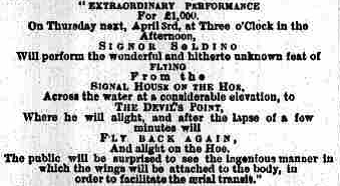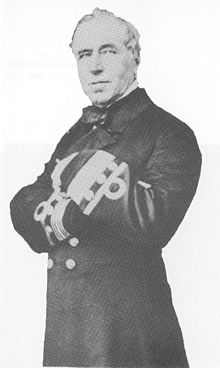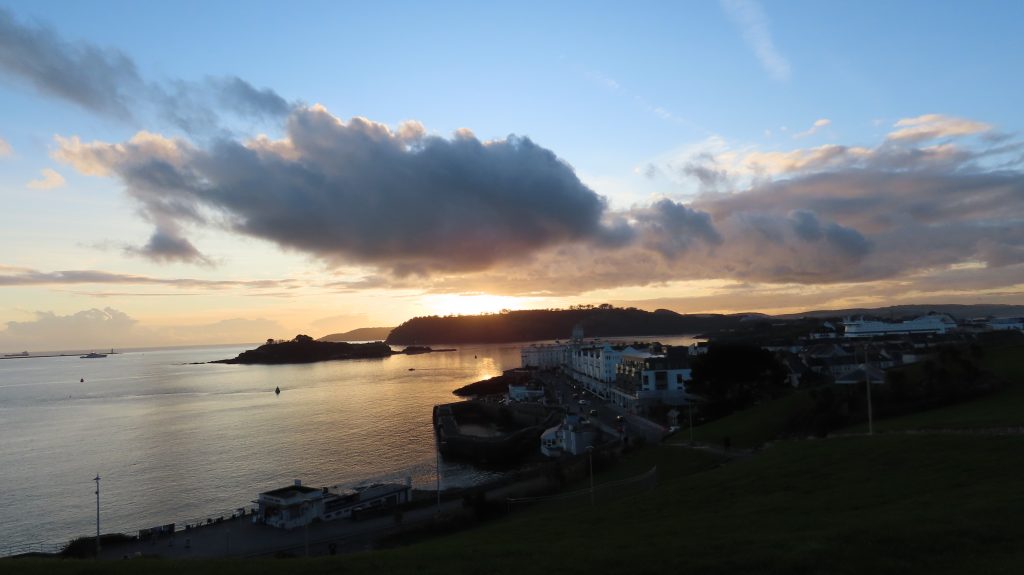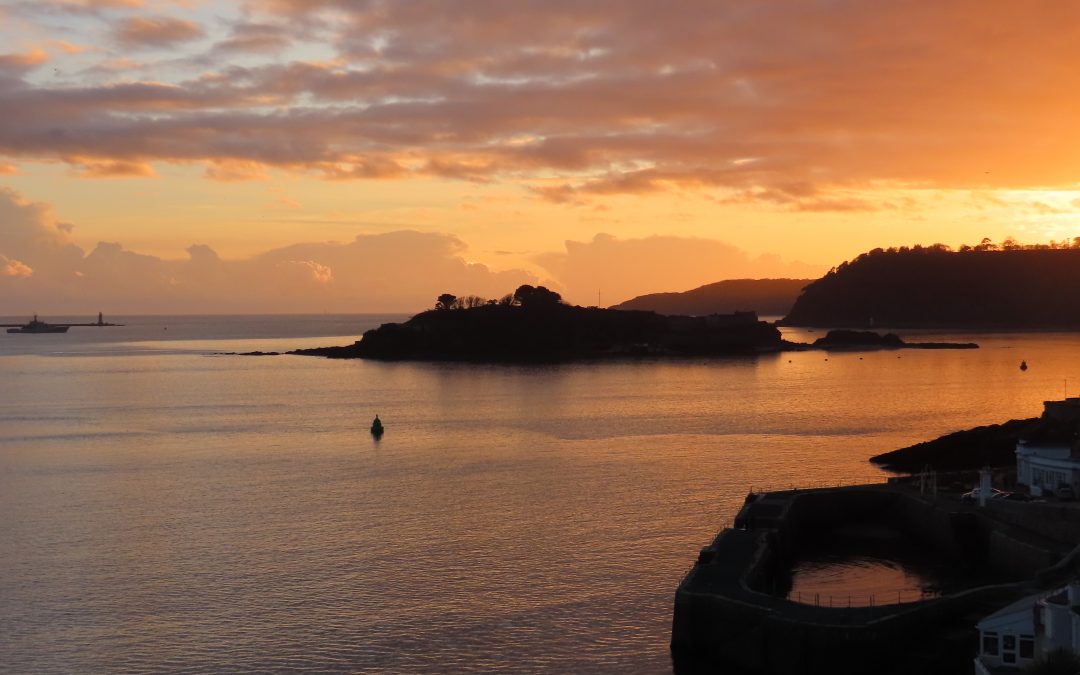During the construction of the casemates there was still a garrison on the Island, mainly provided by units of the Royal Artillery and the routine of Garrison life went on. Soldiers got into trouble, training and experiments were undertaken and one or two unusual incidents took place including an April Fools prank on Plymouth and the unfortunate death of a waterman during Artillery practice.
Back in 1860 just before the construction started Private William Pickering of the Royal Artillery was clearly desperate for a drink and tried to use fake coin to buy his ale at the canteen on the Island. He was tried in a civilian court with using counterfeit coin namely “two bad half-crowns and half-sovereign, at the Canteen”. Found guilty he was given six months imprisonment with hard labour.
1862 saw an April Fools prank played on the people of Plymouth. On the 1st April handbills appeared around Plymouth declaring a Professor Soldino would fly from the Hoe to Devils Point and astound people with his means of flying. This was the era where many experiments were being carried out into flying amongst other inventions. Stands were erected on the Hoe and according to newspapers reports the whole of Plymouth turned out with thousands gathering on the Hoe and down into the park despite a Battalion of Marines carrying out drill practice and charging about with bayonets fixed. As time wore on and neither Professor Soldino nor his flying contraption appeared it became clear that the people of Plymouth had been hoaxed. A decade later a Mr Edwards wrote into the papers claiming he had overheard a bet being made between some military officers from Drake’s Island about getting a crowd of 20,000 on the Hoe and the plot about Professor Soldino was hatched as a result though we have no more than Mr Edwards unverified claim as evidence of the Officers involvement.

Roughly a year later a similar number of Plymothians gathered on the Hoe to watch experiments to see if lights developed by Mr Hearder could be adapted as military searchlights. The experiments were carried out by Captain Drake of the Royal Engineers with the lights installed at the Citadel and shone around various points within the Sound, including Drake’s Island, each manned by a Royal Engineer Officer to report on the effectiveness of the light at their point. According to newspaper reports the lights were relatively expensive and required 80 battery cells but could benefit the military. Within around 30 years the technology had developed to such an extent that military searchlights were deployed on the Island and in other defensive locations in the Sound as well as on board Royal Navy ships.
Later in the same year 7 of a party of 9 people from the Garrison died as a result of a boat accident. The Garrison was manned by No7 Battery, 5th Artillery Brigade and 6 Gunners along with 3 wives had been in the Barbican area getting stores, including at least one barrel of Porter for the Island. The nine were Sergeant and Mrs. Drew, Gunners Stevens, Hamlin, Hawkins, Sivley, and Johnson along with Mrs Brown and Mrs. Wilson. It seems on the return to the Island as the boat made a turn a barrel of Porter rolled upsetting the trim of the boat causing it to capsize. 6 of the party drowned in the Sound but Gunners Sivley and Johnson managed to grab hold of Mrs Drew and get her to shore where she unfortunately died making the total number of deaths 7.
The Artillery batteries around the Sound practiced by firing hollow shot with a reduced charge at various target buoys tethered in the Sound mostly between the Island and Breakwater. A few were close to Drake’s Island and when firing sentries at the firing point were supposed to warn boats using flags and trumpets and check the fire of the guns if boats were in range. There had been a number of near misses over the years including when a shot passed within 20 yards of a boat carrying Admiral Dacres who wrote a strongly worded complaint to Horse Guards (the Army HQ at the time). Unfortunately in 1864 the boat manned by two local watermen, George McCoy and James Hellen was hit by an 8 inch hollow shot which inflicted severe injuries to the legs and lower spine of George McCoy. With their boat sinking James Hellen managed to keep George afloat until help arrived and they were taken ashore. Unfortunately George McCoy who was only 19 or 20 years old died later that day. Until safer arrangements could be made all artillery practice was transferred to Drake’s Island presumably as the batteries pointing out to the Breakwater overlooked a quieter part of the Sound.


1865 saw another two Gunners lose their lives using a boat between Plymouth and the Island and not for the first time drink was involved. Gunners Charles Branton and Alexander Jack with Trumpeter Williiam Gouldson left Drake’s Island heading for Mount Wise. As the Gunners were both drunk but Trumpeter Gouldson was sober he rowed while the Gunners sat in the stern. Just off Devils Point the Gunners for some unknown drunken reason got into an argument that developed into fight. They ended up overboard and Gouldson lost the oars. Subsequently the two Gunners were carried away and drowned whilst the boat with Gouldson on it drifted onto the rocks where the coastguard having been alerted by Royal Marine sentries helped him take the boat round to Royal William Yard.
By 1868 the 8th Company of the 7th Artillery Brigade were on Garrison duties on the Island who were in turn replaced by 1st Battery 13th Brigade in 1869. To give a rough idea of numbers a census taken on the Island in 1871 when 1st Battery was still on Garrison duty showed 60 adults and 12 children on the Island. As 6 families were shown presumably there were 6 females meaning the strength of the battery was 54 Officers and men. Whether the posting was not to his liking I don’t know but almost immediately on arrival Gunner Henry Costello deserted with his kit. However he was caught shortly after by the Police in Ivybridge having stolen a £5 note. He was given 4 months imprisonment for the theft and arrested by the military immediately on his release in 1870 and court martialled for desertion and selling his kit. Sentenced to 56 days hard labour he was also marked with the letter D for being a deserter. Another deserter was Gunner John Maddocks who was confined to the Guardroom on Drake’s Island and escaped. He was caught after a short period on the run and was sentenced to 84 days imprisonment with hard labour, also marked with the letter D and had stoppages of pay for selling his kit. Corporal James Kennedy meanwhile embezzled £13, 14s 11d from the canteen and went on the trot (AWOL) for 9 days. Found guilty he was reduced to the ranks with 84 days imprisonment and stoppages to pay for the embezzled monies. 1871 was no better and Gunner Saunders was court martialled for striking Sergeant Goode, and being AWOL from Drake’s Island the some date. Gunner Saunders having been found guilty Gunner Seaward, a witness who had given evidence on behalf Gunner Saunders was arrested and for wilful and corrupt perjury. Gunner Mason was charged with being drunk the barracks Drake’s Island.

I don’t know if it was the problems with 13th Brigade that caused a change but by 1873 3rd Battery of 12th Artillery Brigade were manning the Island. An 1873 garrison return showed 60 males and 13 females on the Island so the numbers were similar to 12th Brigade although the Garrison would soon gain a notoriety that would surpass that of 12th Brigade with a mutiny within months of their arrival but more of that next week.

